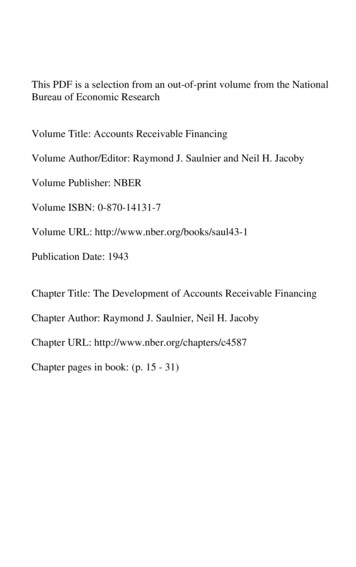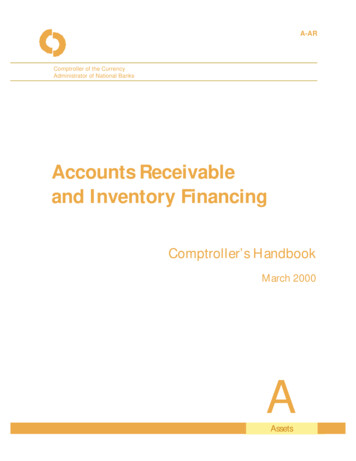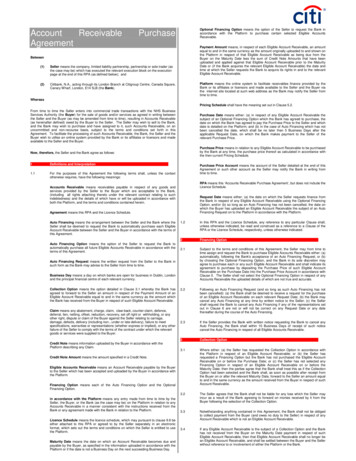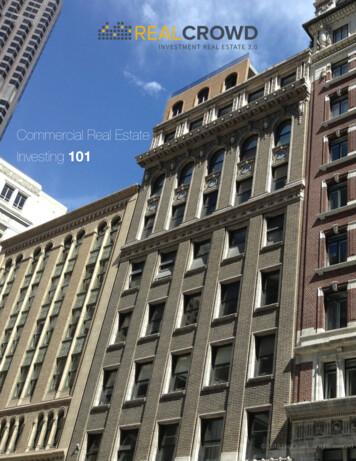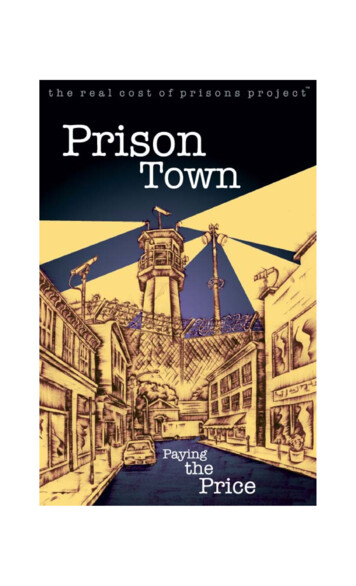
Transcription
prison town pdf.qxd2/7/057:36 PMPage iiwww.realcostofprisons.org info@realcostofprisons.orgPrison TownPaying the PriceArtist: Kevin Pyle Writers: Kevin Pyle & Craig GilmoreReal Cost of Financing and Siting of Prisons writer/presenter: Craig GilmoreArt Director & Cover Design: Chris ShadoianReal Cost of Prison Project Director: Lois AhrensThe Real Cost of Prisons Project brings together prison/justice policy activists with politicaleconomists to create workshops and materials which explore both the immediate and long-termcosts of mass incarceration on the individual, her/his family, community and the nation.Two additional comic books are part of this series: Prisoners of the War on Drugs and Prisoners ofHard Times: Women and Children. If you would like copies of these comic books to assist your groupin its organizing work, contact Lois Ahrens. Or you can go to www.realcostofprisons.org anddownload the entire series.This comic book can be downloaded free of charge from the Real Cost of Prisons website. Please credit theReal Cost of Prisons Project. Any reproduction requires written permission of the Real Cost of Prisons Project,except for small excerpts for review or publicity purposes.The Real Cost of Prisons Project is an activity of The Sentencing Project, a Washington, DC based non-profitdedicated to reducing over-reliance on incarceration. The Real Cost of Prisons Project is supported by a grantfrom the Community Advocacy Project of the Open Society Institute.THANK YOURuth Wilson Gilmore, Tracy Huling, Peter Wagner, Eric Cadora, Todd Clear, Dina Rose, N.C. Christopher Couch,James Heinz, Marc Mauer, Malcolm Young, Raquiba LaBrie, William Johnston and Helena Huang.Art and stories are and TM 2005 The Real Cost of Prisons Project.Write to us at 5 Warfield Place, Northampton, MA 01060. All Rights Reserved. Printed in Canada.Please visit the Real Cost of Prisons website at www.realcostofprisons.org
prison town pdf.qxd2/7/05Anytown U.S.A.7:36 PMPage 1- once a thriving farm community - has fallen on hard times.The 1980’s and 90’s brought both thedecline of the family farm andthe loss of rural factories.The jobs that Stuckaround tended to below-wage and moneyout of the town.So local officials ofthese towns startedlooking around for anew “growth” industry.we needto dosomething!I’m tellingyou— it’s theperfect thing.Well, i supposethere’ll alwaysbe work.Sometimes it foundthem first.Please visit the Real Cost of Prisons website at www.realcostofprisons.org
prison town pdf.qxd2/7/057:36 PMPage 2Due to mandatory sentencing, three-strikesyou’re-out and Harsh drug laws,the prison population has grownby more than 370% since 1970.1Most of these prisoners arejailed in rural America.Between 1990 and 1999, 245 jails and prisonswere built in ruraland small towncommunities, witha new one openingsomewhere everyfifteen days.12There are moreprisons in Americathan Walmarts. There are moreprisoners in America today than farmers.3These prisoners are now seenas an economic opportunity.“When legislatorscry ‘Lock’em up!,’ theyoften mean ‘Lock’emup in my district!”4-former New York Statelegislator Daniel Feldman.Please visit the Real Cost of Prisons website at www.realcostofprisons.org
prison town pdf.qxd2/7/057:36 PMPage 3In the beginning of the Building boom,federal and state authorities oftenoffered rewards to towns to buildprisons. Wanting to get a piece of the49 billion pie, many towns now compete for the chance to have a prison.to be considered “competitive” in the bidding wars for prisons, some townssweeten the deal with free land,upgraded sewer and water systems,and housing subsidies for guards.Federal and State officials, private-prisonsalesmen or, more recently, investmentbankers will visit the potential hosttown in order to sell the idea.Such meetings aredone quietly, oftenbehind closed doors."Premature disclosure,"according to theEncyclopedia ofAmerican Prisons,While local officials charged with the task ofcreating jobs and revenue maywant a prison or to expandIt’s a non-polluting,their jail, the general publicwell-paying, recession-proof industryoften needs more convincing.that goes 24/7, 365days a year.can make siting aprison difficult becausethe public might findout before thedeal is set.5Town meetings are sponsored andcommunity groups lobbied. A JusticeDept. briefing advises “Limiting thetime period for decisionmaking.”6Typically a PR campaignwill be launched, floodingthe local Newspapers andTV with positive spin onthe benefits of building aprison.I’m just not gonnabe able to makethat meeting‘morrow night.Please visit the Real Cost of Prisons website at www.realcostofprisons.org
prison town pdf.qxd2/7/057:36 PMPage 4In 1996, Oregon sited six prisons in six months underOregon’s “super siting law” which madeprisons exempt from state levelenvironmental review.7In Mendota, CA where theFBoP wanted to build a 5prison “corrections complex.”the Environmental ImpactStatement was availableonly in English despite the factthat 86% of the local populationspeaks spanish. Eventually aSpanish-translated 10 pagesummary of the 1000 pagedocument was provided.8A Florida D.O.C. task forcefound that local zoninglaws hinder acquisition ofland for new facilities. Inresponse, the legislaturepassed the CorrectionalReform Act of 1983, whichgave the state theauthority to overridelocal governments inselecting sites forcorrectional facilities.9Reeves county, Texas issued 3 bonds over 15 years, 90 million, to build 3 facilities in the dying oil townof Pecos. Judge Jimmy Galindo, the driving forcebehind the deal says: “. we live in a part of thecountry where it’s very difficult to create and sustain jobs in a global market. [Prisons] become a veryclean industry for us to provide employment to citizens.”“I look at it as a community development project.” 10Many municipalities are expanding their jail facilities in orderto rent beds to overcrowded federal and state prisons.Please visit the Real Cost of Prisons website at www.realcostofprisons.org
prison town pdf.qxd2/7/057:36 PMPage 5Sanilac County, MI hopes it will get about 900,000in revenue this year from renting beds.11In Stanley, WI private developers managed to siteand build a 60 million 1,326-bed prison without oneelected official casting a vote or signing a bill.12In 2001 the state bought the prisonfor 82.5 million.13Today inMississippi,where the cellsupply hasoutrun thecriminalsupply, lawmakers, localsheriffs, andprivate-prisoninterests areall competingfor the scarcesupply ofprisoners.15“It flatly introduces moneyand the desire for profit intothe imprisonment policy debate,because you’ve got an entity inWisconsin, a private entity, witha strong financial interest inkeeping people in prison andhaving them sentenced toprison.”14 -Walter Dickeyformer Wisconsin statecorrections chief.One website,JailBedSpace.com, connects renterswith sellers. “It’s a good marketingtool,” say Lt. Robert LeFever of thePutnam County Correctional Facility,which rents out an average of 60beds per day.16In Anytown U.S.A., where prisonsare seen as economic saviors, leaders find a way to approve themdespite whatever reservations thelocals may have.So the PRISON is built and the prisonersarrive and the town waits to see whatit will become.Please visit the Real Cost of Prisons website at www.realcostofprisons.org
prison town pdf.qxd2/7/057:36 PMPage 6LandHow Prisons Are Paid For (and who really pays?)stsco“We’d like to provide more money for schools, colleges, housing,health care,. but there just isn’t enough to go around.” SaleIncomesTaxrison Cost of Building P Education SpendingSocial Services andTinghHiste repaymentst bondATaxesYour GovernmentXxesProperty TaBondEseaw EnforcemenseedUnseen Costs to CommunitiesdLtNWhat is a bond? A bond is a loan made to a government. Governments pay investment bankers to make theloan attractive ('structure the deal') and find lenders('issue the bonds'). Governments then pay lenders ('bondholders') principal and interest on the loans.Governments issue two broad categories of bond:General Obligation (GO) bonds and Revenue Bonds.io natAdditionalnmental DegradirovnIncreaSEionuitTteS tapurchases andwith PrisonsGeneral Obligation bonds are guaranteed by the taxingpower of the state. Most GO Bonds require approval bythe voters, and in many states by 2/3 of the voters.Revenue Bonds are designed to be paid off by revenuesgenerated by the project being built, like highway tolls,bridge tolls, student tuition, etc.Please visit the Real Cost of Prisons website at www.realcostofprisons.org
prison town pdf.qxd2/7/057:36 PMPage 7and the next.Planning cosExpengnitaerr’s OpaeYNextsestsConstruction costsInvestment Banand the next.and the next.and the next.and the next.ksutionsnd campaign contribonicesStrainl and MedicalciaSverSoBond HoldngExpenseYour Prisonersisl PrauA nnonirateOpMost prisons are now built with some form of Revenue Bond,even though prisons generate no real revenue and RevenueBonds cost taxpayers more to repay. Why would a state use themost expensive way to borrow money to build prisons? Becausevoters have consistently voted down GO Bonds to build moreprisons. Using revenue bonds to build prisons is a means of getting around the voters and taxpayers.RevenuePlease visit the Real Cost of Prisons website at www.realcostofprisons.org
prison town pdf.qxd2/7/057:36 PMPage 8In the 1990’s, an average of 25 prisonsa year were built in rural America.17Cuttingit closetoday.Hi Sam.Hey Dad.On average,80% of newprison jobsgo to folkswho don’tlive, or paytaxes,inthe prisontown.18Just ‘liminatinginefficiency.Can’t arguewith that.79 went to local residents.19In Delano, CA the newprison created 1,600 jobs.coffeehelpyou?Nationally, prison employeeshave shown little interestin buying homes in a newprison town.So you hear about theDunkin Dougnuts going in?Right across fromthe prison?You can bet I Toldthe Mayor what Ithought of that.Yea.And, as it turns out, prisons attract chainstores, which push out locally-owned business.20Please visit the Real Cost of Prisons website at www.realcostofprisons.org
prison town pdf.qxd2/7/057:37 PMPage 9AccordingtoThomasJohnson, an economistat the University of Missouri, prisons are not verygood economic development strategies becausethey create few links tothe local economy.21We still need to havethat “college” talk.Oh yeah.Prisons generally order food and suppliesfrom centralized state warehouses - notlocal grocery or hardware stores.22Cutting itclose today.Community work projects performed by prisoners arevery common and prison officials see them as good "community relations."23 In the past,however, these jobs employedlocal residents who payed taxes and spent locally.What I’m telling you is thatgoing to community collegewill broaden your options.I hear they got goodjobs at the ta goto class.I wouldn’t hold your breath.Excuseme.Besides is that the kind of jobyou want? Locking people up?Sounds coolto mePlease visit the Real Cost of Prisons website at www.realcostofprisons.org
prison town pdf.qxd2/7/057:37 PMHey Honey, sorryto bother you.Page 10Jean’s out so I’mgoing to go aheadand pull a double.One thing most towns don’tanticipate is an increasedstrain on hospitals.Well, we cansure usethe money.S’okay.And social services.After a prison was built in Susanville, CA, CarolJeldness,a mediator for the Family Court, sawhercaseload,—mainlychildcustodyanddivorce, jump from 167 to 320 in one year.24"I spent 8 to 16 hours a day in solidbullshit,.You hear cursing all day,and you come home and that's allyou think about. It did tragedy onmy family." - Guard at Susanville prison25You can callanytime, dayor nightAnother social cost is arise in juvenile problemswith drugs and violence.Thoughtyou’d wantto know.A common response to this problemis to expand the juvenile jail.Please visit the Real Cost of Prisons website at www.realcostofprisons.org
prison town pdf.qxd2/7/057:37 PMPage 11In the competition to lure prisons manyrural towns have put the interests of theprison before the interests of it’s residents.Reeves county still has to servicethat debt as well all the operatingexpenses of the 3 prisons. 26"Wastewater management hasbeen a major issue at every newprison we have built."28-FormerReeves county, Texas found itself servicinga bond debt close to 1/2 million a monthfor three prisons they built on spec. Whenthey couldn’t keep one of them filled, theypaid 62,000 a month to GEO Group, a privateprisons corporation, to find inmates.In Lakeview, Oregon a contract withthe prison says that in event of watershortages the prison has priority.27Social, environmental and economic problems like these mayseal the fate of a prison town.Colorado DOC director John Suthers"Once you have the reputation of aprison town, you won’t become aFortune 500 company town, or anInternet or software companytown, or even a diverse tourismand company town."29Please visit the Real Cost of Prisons website at www.realcostofprisons.org
prison town pdf.qxd2/7/057:37 PMPage 12So now Anytown, U.S.A. is Prison Town, U.S.A.,like Thousands of towns across the country.!KNHOOver the past 25 years, mostprison towns have grownpoorer and more desperate.Prisons are another problem,not A solution.What is unknowable iswhat the prison will do tothe hopes and dreams ofthe people who live here.Those who can leaveand those who can not. . .Please visit the Real Cost of Prisons website at www.realcostofprisons.org
prison town pdf.qxd2/7/057:37 PMPage 13Million DOLLAR blocks30There are blocks in Brooklyn, NY,and other places, where the government is spending 1 million a year.31The money is not being spenton drug treatment programs.It’s not being spent on prenatal care or health care.It’s not being spent oneducation or job training.It’sIt’s beingbeing spentspent onon imprisonment.imprisonment.Please visit the Real Cost of Prisons website at www.realcostofprisons.org
prison town pdf.qxd2/7/057:37 PMPage 14In the U.S., 58 %of people arein prison fornon-violentdrug offenses.32In New York, 75% of the prisonerscome from 7 African-American andLatino neighborhoods.33Peoplepeople of color make up 87% ofthe New York prisonpopulation growthsince 1970’s.3465% of femaleU.S. stateprisonershave youngchildren.3587% of prisoners inNew Yorkare cagedmore than2 hoursfrom NewYork City.All right darlings suit up - it’s time to go.AUNTIE!!36Please visit the Real Cost of Prisons website at www.realcostofprisons.org
prison town pdf.qxd2/7/057:37 PMPage 15There is little evidence that removing so manypeople from a community makes it safer.In fact, given the huge concentration of people beinglocked up from targetedneighborhoods, the oppositeappears to be true.37When you turn someone into aprisoner you put them on a roadthat is very hard to get off. Twoin three people will end up back inprison - half of those due to paroleviolations, not new crime.*38When you turn someone into a prisoner, you transfer their economic andsocial power, real or potential, to thepeople who build and work in prisons.They can no longer vote, take care oftheir kids, or provide for their family.With each person removed from acommunity, the social and economicbonds break down a little more.With 98% of people leaving prison returningto that same, unchanged block, a placewithout jobs, effective drug counseling, oraffordable housing,39 does it make sense tospend a million dollars this way?So what ifthat moneywas spenton otherthings?Please visit the Real Cost of Prisons website at www.realcostofprisons.org
prison town pdf.qxd2/7/057:37 PMPage 16In Oregon and Ohio programs areattempting to change this by rechanneling money back into the high crime areas.In Deschutes County, the state turnedover the cost of locking up youth, 50,000per youth per year, to the County.By making local officials andparole officers responsible forspecific communities, they haveprovided a direct incentive tomake the streets safer.The County had the less violent youths serve their sentences by performing community service, whichreduced the youth imprisonment by 72%.This also saved 17,000 per case that they could reinvest in schools,libraries, drug treatment, and other programs.40Research shows that quality education is one of the most effectiveforms of crime prevention41 anddrug treatment programs costmuch less than imprisonment.So instead of removing people, the communityseeks to help them stay out of prison.Where they belong.Please visit the Real Cost of Prisons website at www.realcostofprisons.org
prison town pdf.qxd2/7/057:37 PMPage 17GLOSSARYCoercive Migration: The movements of people from theirneighborhoods, through the courts and jails to prison andback. The concentrations of large numbers of prisoners incertain rural prisons and the fact that their former homes areconcentrated in relatively few neighborhoods of urban poverty leads to huge impacts for the urban neighborhoods whodeal with constant turnover of their population and disrupt theunity of family and neighborhoods.Community Reinvestment: The alternative to “Million DollarBlocks.” A program that redirects money spent on prisons toinvestment on the blocks where current or formerly incarcerated men and women live, spending money on health care,job training, education, drug treatment and other servicesinstead of incarceration.Corrections: (as in Department of Corrections) Term usedwith no apparent sense of irony to describe governmentdepartments in charge of prisons and the prison industry asa whole.Criminalization: the process of making behaviors illegal or ofradically increasing the severity of the punishment. Also usedto describe the populations targeted by these policies, forexample, the criminalization of the homeless or of Blackyouth.Development Subsidies: the opposite of mitigation funds.Subsidies are money paid by local or state governments toattract or retain businesses. They can include city or state taxbreaks, tax-advantaged financing, investment in roads, housing or transportation funds for industry employees. Such subsidies, often called "Corporate Welfare," rarely pay off for thetown.Industry of Last Resort: those industries who have troublefinding host communities because they are unpleasant neighbors, for example: incinerators, prisons, concentrated animalfeeding operations (CAFOs), toxic waste dumps. Industries oflast resort seek communities desperate for jobs and tax revenues and where they believe people will not exercise theirpolitical power. For example: poor rural communities andinner city neighborhoods.Million DollarBlock: A city block in which the state is spending 1,000,000 or more to incarcerate former residents or tosupervise the formerly incarcerated.Mitigation: state money paid to local governments to pay thecosts of siting including extending roads, sewage pipes,increased use of courts, etc. Mitigation offered by the state isusually far short of the real costs to the host community, leaving them in a deeper financial hole.Police State: (1) Any state or country that relies primarily onpolice and prisons to control some or all of the population.(2) A state dependent on fear to keep people in order. (3) Aplace in which 'safety' is defined narrowly as security fromacts of random violence rather than, for example, freedom todrive a car and not be stopped and searched for no reason.Prison Industrial Complex: (often PIC): an informal or formalalliance of government bureaucrats, politicians, private industry, bankers, real estate developers and labor leaders whopush criminalization, harsher sentences, more police andprisons which increases their political power and/or privateincomes.Siting: (Host) The process in which a prison (or other industry) chooses a location and convinces that community to welcome it. The community in which the prison is built is calledthe “host.”FOOTNOTES1: Peter Wagner, The Prison Index, 2003, pg. 5, www.prisonsucks.com2: Calvin Beale, “Cellular Rural Development: New Prisons in Rural andSmall Town Areas in the 1990’s,” paper prepared for presentation at theannual meeting of the Rural Sociological Society, Albuquerque, NewMexico, August 18, 2001. “From Building a Prison Economy in RuralAmerica,” by Tracy Huling, pg. 23: America’s Diverse Family Farms, Agriculture Information Bulletin 769,Economic Research Service, US Department of Agriculture, May, 2001.From “Building a Prison Economy in Rural America,” by Tracy Huling, pg. 1.4: Daniel Feldman, "20 Years of Prison Expansion: A Failing NationalStrategy," in Public Administration Review, Vol. 53, No. 6,November/December, 1993. From “Building a Prison Economy in RuralAmerica,” by Tracy Huling, pg. 205: Critical Resistance East California Prison Moratorium Project, New Formsof Environmental Racism,www.criticalresistance.org.6: Issues in Siting Correctional Facilities, Department Of Justice, pg. 177: Prison Siting Forces Lawsuit Against U.S. DOJ, Western Prison Project,westernprisonproject.org.8: Critical Resistance East & California Prison Moratorium Project, NewForms of Environmental Racism,www.criticalresistance.org.9: Issues in Siting Correctional Facilities, Department Of Justice, pg. 1710: Sasha Abramsky, “Incarceration Inc,” The Nation, 7/19/04.11: David Jesse, “Cells For Rent,” Times Herald, 5/11/04.12: Richard P. Jones and Mary Zahn, “Decision to Build Prisons Moves Outof State’s Hands,” Milwaukee Journal Sentinel, 1/23/00.13: Charles Westerberg, “Tough on Crime, Easy on Big Business,”FightingBob.com, 6/26/03.14: Richard P. Jones and Mary Zahn, “Decision to Build Prisons Moves Outof State’s Hands,” Milwaukee Journal Sentinel, 1/23/00.15: Charlie Mitchell, “Competition is Fierce for an Unusual Asset: PrisonInmates,” Vicksburg Post, 6/3/04.16: “Web Site Connects Jail-Bed Renters with Sellers,” www.correctionalnews.com, 7/10/04.17: Peter Wagner, The Prison Index, 2003, pg. 3518: Ruth Wilson Gilmore, Golden Gulag, University of California Press, 2005,From Building a Prison Economy in Rural America by Tracy Huling, pg. 6.19: “Storm Raised by Plan for a California Prison” New York Times,8/27/200020: Tracy Huling, “Building a Prison Economy in Rural America,” pg. 7.21: Douglas Clement, “Big House On The Prairie,” Fedgazette, FederalReserve Bank of Minneapolis, Vol. 14, No. 1, January, 2002. “FromBuilding a Prison Economy in Rural America,” by Tracy Huling, pg. 7.22: John K. Wiley, “Study: Hosting Prisons Could Harm Small Towns’Economic Prospects,” Associated Press, 7/17/04.23: Tracy Huling, “Prisons as a Growth Industry in Rural America: AnExploratory Discussion of the Effects on Young African American Men inthe Inner Cities,” 05/15/99.24: Joelle Fraser, “An American Seduction: Portrait of a Prison Town.”25: Ibid26: Sasha Abramsky, “Incarceration Inc,” The Nation, 7/19/04.27: Prison Siting Forces Lawsuit Against U.S. DOJ, Western Prison Project.28: Stephen Raher, “Research Memo Re: Economic Impacts of RuralPrisons,” Colorado Criminal Justice Reform Coalition. 5/22/2003.29: Tracy Huling, “Building a Prison Economy in Rural America,” pg. 12.30: This chapter is heavyily indebted to the work of Dina R. Rose and Todd R.Clear, “From Prison to Home: The Effect of Incareration and Reentry onChildren, Familes, and Communities,” 12/0131: Susan B. Tucker and Eric Cadora, “Justice Reinvestment,” Ideas for anOpen Society, vol.3 number 3, 11/03, pg2.32: Peter Wagner, The Prison Index, 2003, pg. 27.33: Tracy Huling, “Prisons as a Growth Industry in Rural America: AnExploratory Discussion of the Effects on Young African American Men inthe Inner Cities.” 05/15/99.34: Peter Wagner, The Prison Index, 2003, pg. 35.35: Ibid, pg. 31.36: Ibid, pg. 26.(PI)37: Dina R.Rose and Todd R. Clear, “Incarceration, Reentry and SocialCapital: Social Networks in the Balance,” 2002.38: Susan B. Tucker and Eric Cadora, “Justice Reinvestment,” Ideas for anOpen Society, vol.3 number 3, 11/03, pg2.*(JR) *Conditions of probationcan be violated for a missed curfew or a "dirty" urine.39: Ibid, pg.340: Susan B. Tucker and Eric Cadora, “From Prisons to Parks in Oregon,”Ideas for an Open Society, vol.3 number 3, 11/03, pg2.41: Tracy Huling, “Prisons as a Growth Industry in Rural America: AnExploratory Discussion of the Effects on Young African American Men inthe Inner Cities.” 05/15/99.Please visit the Real Cost of Prisons website at www.realcostofprisons.org
If you would like copies of these comic books to assist your group in its organizing work, contact Lois Ahrens. Or you can go to www.realcostofprisons.org and download the entire series. This comic book can be downloaded free of charge from the Real Cost of Prisons website. Please credit the Real Cost of Prisons Project.
